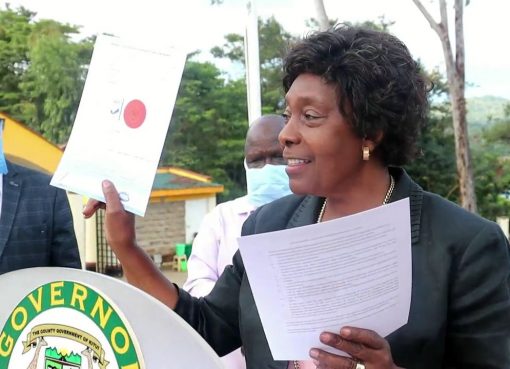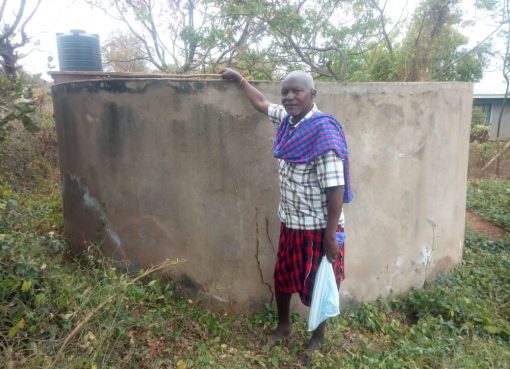Farmers in Nyeri can now start preparing their pieces of land for planting after the Kenya Meteorological Department released its weather outlook for the October-November -December rain season.
According to the report, the climate outlook for the period under review indicates that the whole country is likely to experience enhanced rainfall, a departure from what has been the norm for the last few years.
The high precipitation will be driven by warmer than average Sea Surface Temperatures (SSTs) over the central and eastern equatorial Pacific Ocean, indicating the presence of El Nino conditions.
Mary Wachira, a farmer in Gatitu village in Nyeri Central told KNA she is currently gathering her maize harvest from her 17-acre farm to enable her to prepare her farm for the next planting season.
The farmer also indicated that this year’s harvest was quite impressive compared with last few years and now hopes the expected El Nino rains will turn out to be a boon and not a curse to farmers.
“I have been keenly following the weatherman’s report regarding the expected heavy rains and look forward to better yields than what I am harvesting now. I am also grateful to God this time round since we have managed to get a good harvest owing to good rains that were experienced during the long rains. Nevertheless, I hope the short rains will not turn out to be a bane to farmers but will enable us to realise even better yields next year,” she says.
Nyeri is one of the counties expected to experience heavy rains throughout the three-month cycle.
According to the Met report,“ Highlands East of the Rift Valley, Nyandarua, Nyeri, Kirinyaga, Murang’a, Kiambu, Meru, Embu, Tharaka Nithi, Nairobi and the Eastern parts of Laikipia will likely experience rainfall throughout the season. Rainfall amounts are expected to be above the season’s long-term average,” says the report.
“The rainfall is expected to be well distributed in both time and space,” continues the outlook.
The report has also indicated that the rains will most likely start during the second week of October and continue till January next year.
Last week local County Director of Meteorological Services John Muiruri had disclosed Nyeri will be spared from any resultant floods and landslides synonymous with some parts of the country during above average rains.
Muiruri also hinted at the possibility of Nyeri experiencing enhanced rains during the short rainy season owing to the influence of the El Nino weather phenomenon.
He nevertheless said the Department would issue a comprehensive report in regard to the October-November-December rains once they completed monitoring the changes in global climatic patterns.
“We are yet to receive the forecast for October -November -December and we are still monitoring the situation because we are seeing signals of having an experience of El Nino.so for now I cannot say whether we are going to receive depressed rainfall but we are still monitoring the situation,” he had explained.
Heavy continuous rainfall is also expected in the Lake Victoria Basin region, Kisii, Elgeyo Marakwet, Bungoma, Trans Nzoia, West Pokot, Vihiga, Laikipia, Nakuru and Narok counties.
The rains will begin in September before picking up in October and will prevail until January.
In the north-western counties of Turkana, Marsabit and Samburu, the met department announced rainfall above the long-term average for the season is expected.
“In the highlands east of the Rift Valley, Nairobi included, rainfall is expected throughout the season above the season’s long-term average. The rainfall will be well distributed in terms of space,” says the weather report.
In the lowlands, above-long-term average for the season is expected while in the north-eastern counties, occasional rainfall of an amount slightly above average for the season will be experienced
Wajir and Mandera counties will get the highest rainfall which will be occasioned by widespread flooding.
Other areas likely to experience flooding include Nyakach, Nyando, lower areas of River Nzoia, Winam Gulf and lower areas of River Sondu in Western Kenya.
In the Rift Valley region, floods are expected is likely to occur in Gilgil, Narok town and Suswa while the coastal towns of Mwatate, Tana River delta and Mwatate have also been identified as high-risk areas.
On July 4 this year The United Nations Meteorological Organisation warned the world to prepare for the adverse effects of El Nino, saying the weather phenomenon which triggers higher global temperatures would persist throughout this year.
El Nino is a naturally occurring climate pattern typically associated with increased heat worldwide, as well as drought in some parts of the world and heavy rains in other parts.
El Nino is the large-scale warming of surface temperatures in the central and eastern equatorial Pacific Ocean.
It usually occurs on average every two to seven years and lingers for a period of nine to 12 months.
“The onset of El Nino will greatly increase the likelihood of breaking temperature records and triggering more extreme heat in many parts of the world and in the ocean,” warned World Meteorological Organization (WMO) secretary-general Petteri Taalas.
“The declaration of an El Nino by WMO is the signal to governments around the world to mobilise preparations to limit the impacts on our health, our ecosystems and our economies,” said Taalas.
“Early warnings and anticipatory action of extreme weather events associated with this major climate phenomenon are vital to save lives and livelihoods.”
El Nino events are typically associated with increased rainfall in parts of southern South America, the southern United States, the Horn of Africa and central Asia.
Kenya last experienced the of El Nino phenomena in 1997, resulting in exceptionally heavy rainfall and deadly floods.
The consequent El Nino in 2015 had a higher index but led to lower rainfall, causing less significant effects than had been anticipated.
By Samuel Maina





